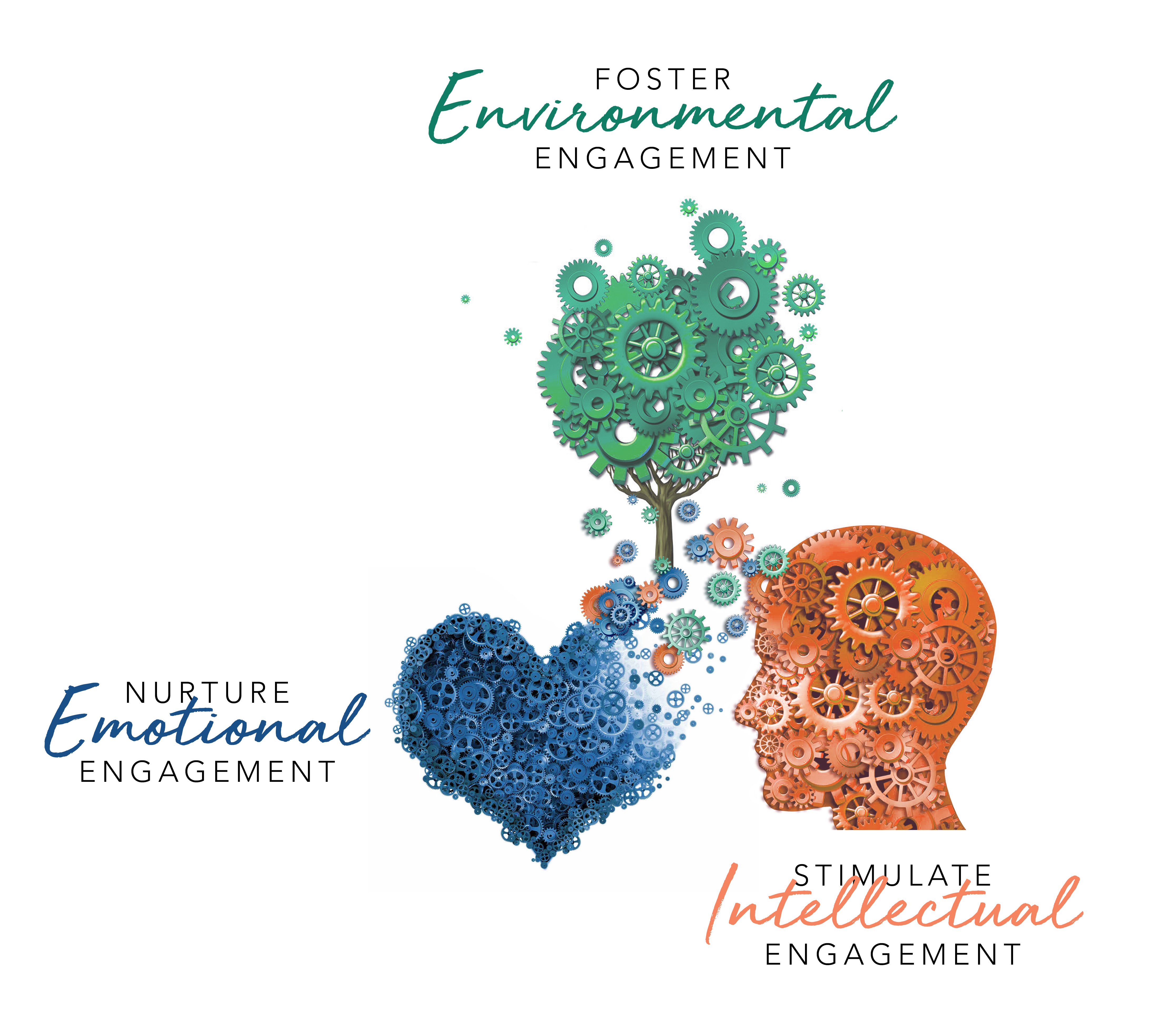Creating Engagement in the Blend
Hybrid Learning is the New Blended Learning Today’s learning environment is complicated. Not only do we need to intellectually engage individual...
8 min read
 Claire Collins
:
Jul 22, 2024 8:00:00 AM
Claire Collins
:
Jul 22, 2024 8:00:00 AM

We know it is important to include everyone, no matter where they’re joining from in a hybrid learning environment, but how do we ensure we’re being neuro-inclusive? How often do you think about neurodiversity within your learner groups? Everyone is unique and everyone processes information differently; therefore, we must consider the options to give all learners a truly engaging experience.

Neurodiversity is an umbrella term that encompasses the full spectrum of neurological processing. It is generally divided into two categories: "Neurotypical," referring to individuals who think, perceive, and behave in ways considered typical by the general population, and "Neurodivergent," which includes a range of neurological conditions such as Autism, Attention Deficit Disorder, Dyslexia, Dyspraxia, and many more. Globally, it is estimated that 15 to 20% of the population is neurodivergent.
Understanding neurodiversity is crucial in creating inclusive environments, particularly in educational and professional settings. Recognizing and valuing the different ways people process information and interact with the world can lead to more effective communication, enhanced collaboration, and a more supportive atmosphere for everyone. By embracing neurodiversity, we can foster environments where all individuals feel valued and empowered to contribute their unique perspectives and talents.
As awareness grows and discussions about neurodiversity become more prevalent, an increasing number of individuals are receiving diagnoses. However, much of the research in this area has historically focused on childhood diagnoses, leaving many neurodivergent individuals without official recognition into adulthood. As a result, your learner groups will likely include a diverse range of neurodiverse learners, each absorbing and processing information differently. Therefore, it's essential to customize training programs to accommodate the varied needs.
Having a safe and well-structured environment will boost engagement when working in a hybrid environment. An example is being flexible with cameras and seating arrangements or ensuring any assistive technology is compatible and working throughout your session. Having technical producer support in all sessions is hugely beneficial to assist with the technology. A producer can also act as a learner advocate, identifying opportunities to be more inclusive and making suggestions to the instructional team to ensure all learners are able to participate fully. Furthermore, consider incorporating multiple modes of instruction to cater to different populations, such as visual aids, interactive activities, and written materials. Regularly solicit feedback from learners to understand their needs and make necessary adjustments. By fostering an inclusive and adaptive learning environment, you can create a more engaging and supportive experience for all participants.
Clarity on session expectations is essential for fostering a neuro-inclusive learning environment. Clearly defined objectives and instructions provide learners with a structured framework, enhancing their ability to engage and succeed.
Begin by facilitating introductions to get to know your learners and establishing a welcoming atmosphere. Set the tone for a safe and inclusive space by explaining how learners can ask questions at any time. This openness encourages active participation and ensures everyone feels valued.
Incorporate breaks into your schedule and inform learners in advance when these breaks will occur. Even providing a rough estimate can be reassuring, as it allows learners to anticipate and plan for downtime, helping them stay focused and engaged. Regularly check in with learners to gather feedback and make necessary adjustments. By creating a structured, inclusive, and flexible learning environment, you can ensure that all learners feel supported and engaged.
By offering alternatives such as simple written instructions for activities, and where possible visual or auditory alternatives, learners can take their time to absorb the learning. A bulleted step-by-step guide for breakout activities is particularly useful. Importantly, ensure that instructions remain accessible once learners are in the breakout rooms. Adding instructions to the chat or sharing slides with breakout groups helps everyone stay aligned with the agenda.
In addition to offering alternatives and clear instructions, creating a learner hub with participant materials can significantly enhance the learning experience. This centralized resource allows learners to access supplementary materials, review key concepts, and further engage with the content at their own pace.
Providing time for reflection is essential for deepening understanding and promoting retention of information. Encourage learners to pause and reflect, explaining that silence is provided to give them space to digest what they have learned. This intentional pause fosters a supportive environment where learners can process information and connect it to their own experiences, enhancing their overall learning journey.
Designing virtual training for neurodiverse learners requires a thoughtful approach that accommodates diverse cognitive and learning needs. Effective virtual training programs should incorporate flexibility in content delivery, allowing learners to engage with material at their own pace. Multimedia resources, such as videos, interactive simulations, and visual aids, can help make information more accessible.
It's essential to create an inclusive environment by using tools that allow for customization, such as adjustable font sizes and background colors, and ensuring that content is accessible to those with sensory sensitivities. Lastly, fostering a supportive online community where learners can connect, share experiences, and receive encouragement can enhance engagement and motivation.
Facilitators can support neurodiverse students during virtual training sessions by employing inclusive and adaptable teaching strategies that benefit all learners. Here are some approaches:
By implementing these strategies, facilitators can create a more inclusive and supportive virtual learning environment that accommodates the diverse needs of all students, including those who may be neurodiverse.
A global tech firm offers a virtual professional development program for its employees to enhance their project management skills. The program includes a diverse group of adult learners, some of whom are neurodiverse, though not all are formally diagnosed or disclosed.
The facilitator first identified the challenges. Some learners may have ADHD, autism, dyslexia, or other neurodiverse conditions that affect their learning preferences and needs. Keeping adult learners engaged and motivated in a virtual setting can be challenging, especially for those struggling with attention or sensory sensitivities. The facilitator must ensure that all content is accessible and understandable to a diverse audience.
The facilitator used clear and structured content delivery, breaking down each module into smaller, manageable sections with clear objectives. She provided detailed written instructions alongside video explanations to cater to different learning preferences. Course materials also included videos with subtitles, audio recordings, infographics, text documents, and interactive elements such as quizzes, polls, and simulations, all integrated to engage learners actively.
All sessions were recorded to allow learners to review content at their own pace. Deadlines for assignments were flexible, with options for extensions to accommodate those who may need more time. Regular check-ins and feedback were provided through automated quizzes and peer reviews, with additional personalized feedback from the facilitator.
A discussion forum was set up for learners to share experiences, ask questions, and support each other.
The facilitator planned group activities and breakout sessions to encourage peer collaboration and networking. To enhance accessibility, tools for adjusting text size, background color, and audio speed in the online platform were provided.
As a result, all learners felt engaged and motivated. Understanding and retention were high, as clear instructions and multimodal resources helped all learners grasp complex concepts more effectively. The group experienced improved accessibility with customizable tools and flexible deadlines, ensuring that neurodiverse learners could participate fully without feeling overwhelmed. Overall, the training successfully built a supportive community, and regular feedback fostered a sense of belonging and confidence among learners. The organizational goals were also achieved, resulting in a clear ROI and ROEI (return on employee investment) for the company.
New research into neurodiversity is constantly taking place, leading to better understanding and enhanced learning outcomes for adults and children alike. A 2024 study by the National Institutes of Health (NIH) suggests that neurotypical and neurodivergent learners experience similar challenges, albeit to differing degrees of intensity.
One area that was as a challenge for both neurotypical and neurodivergent learners was focusing their attention. Facilitators could positively or negatively impact cognitive load in online learning depending on the study environment, the flexibility of the online course, information access, and levels of stress and motivation. Learners used various strategies to manage their cognitive load in online learning, such as pausing or replaying the recording, planning their study time, seeking additional resources outside of the core material, and taking breaks.
Taking breaks was particularly important for neurodivergent learners, who felt overwhelmed by long online lectures. Notably, taking notes was only mentioned by neurotypical learners as a way to manage their cognitive load in online learning. Overall, the results suggested that neurotypical and neurodivergent learners face similar challenges with regard to cognitive load in online learning but at varying levels of intensity. As noted earlier, inclusive design practices may benefit all students.
Organizations are increasingly embracing neurodivergent employees and finding that neurodiverse groups are better at creative and unconventional thinking and pattern recognition and have stronger observational skills. Adapting the workplace and workplace training to suit their needs isn't just a nice thing to do—it's a smart business decision.
Remember, there is a wealth of valuable information available on neurodiversity. Consider following real neurodivergent individuals on social media to gain insights and perspectives directly from their experiences. Engaging with their stories and perspectives can deepen your understanding of neurodiversity and cultivate greater empathy and inclusivity in your interactions and practices.
https://uptimize.com/salesforce-uptimize-case-study/
https://www.bestcolleges.com/resources/companies-leading-neurodiversity-movement-tech/
https://www.ncbi.nlm.nih.gov/pmc/articles/PMC11020716/
https://www.linkedin.com/in/pete-wharmby-58a2131b2/
https://www.linkedin.com/feed/update/urn:li:activity:7163455293807382528/
https://www.linkedin.com/pulse/navigating-workplace-dyslexia-challenges-james-sillett-7cs2e/

Hybrid Learning is the New Blended Learning Today’s learning environment is complicated. Not only do we need to intellectually engage individual...

Our research identified that learner engagement turns on three factors: An emotional response to the training—How does the learner “feel” about the...